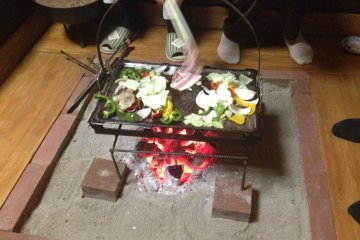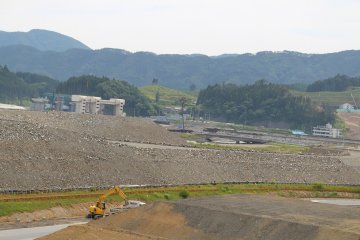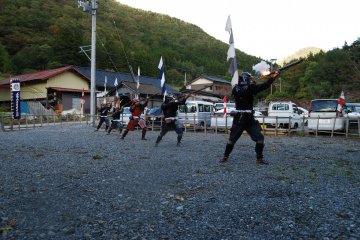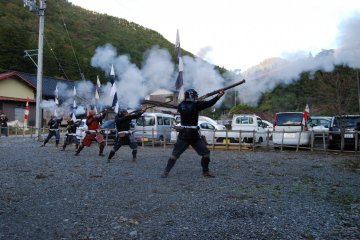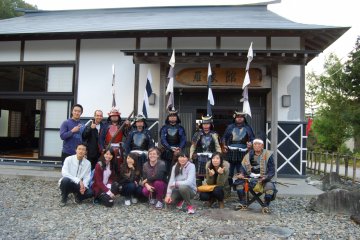If exploring caves or panning for gold hasn't quite filled your appetite, prepare to be blasted back to early Edo Japan by Sumita town's very own Matchlock Rifle Brigade (Goyōzan Hinawajū Teppōtai).
Matchlock rifles or hinawajū (hinawa, meaning fuse, is made from the bark of a species of Japanese cypress, hinoki, while jū refers to firearm) first made their way into Japan during the late Muromachi Period (1337-1573) through the island of Tanegashima, south of Kyūshū. Oda Nobunaga (1534-1582) a famous warlord of the Azuchi-Momoyama Period (1573-1600) used matchlock rifles extensively in his military campaigns, using a rank and file system whereby one line of troops would open fire while the following rank was reloading.
Cast your mind back to pre-Meiji Japan and you will find that Japan was divided into a system of fiefs (han) each governed by a local warlord under the ruling military government, or Bakufu. The area occupied by Sumita-cho was formerly part of Date-han (this is pronounced da-te as in ‘café late’ not as in ‘date’ in English), ruled by Masamune Date (1567-1636) an influential and wealthy lord (daimyō) of the early Edo Period (1600-1868). (If you have any interest in Date Masamune, some of his calligraphy is on display in Tokyo National Museum.)
Hinoki cypress, its bark an essential material in making the fuses of matchlock rifles, is found in the mountains around Sumita. Old records indicate that the annual production rate of fuses in the Edo Period was around 14,000 hiro, (hiro is an archaic unit of measurement equal to 1.818m), making the total output in excess of 21km. Historically therefore, the Goyō area of Sumita-cho was the largest single producer of fuses in the Edo period. That makes for one big fuse!
In recognition of this historic past, the Matchlock Rifle Brigade was formed back in February 1991. Another important function of the brigade is to help transmit long standing traditions in Sumita-cho to younger generations. In this way, senior members of the local community that studied the art of making hinawa fuses in their youth and an old school of martial arts (Morishige-ryū) dedicated to the technique of matchlock rifle handling, are able to offer valuable instruction to the group. This instruction even extends as far as learning how to make armour and helmets.
I was lucky enough to see a demonstration of the Goyōzan Matchlock Rifle Brigade in the grounds of the Sumita-cho village hall which enjoys a splendid view of the home of hinawa fuses, Mount Goyō (Mount Goyō is part of Goyōzan Prefectural National Park) . The brigade, assembled outside of the village hall, consisting of 6 members on this occasion, were adorned with traditional armour and period matchlock rifles, as well as a katana (a style of Japanese sword that emerged in the 16th century). It should be noted that the matchlock rifles do not fire projectiles but are loaded with gunpowder. The group moved about in formation taking up different firing positions both standing and kneeling. The noise is terrific as is the smoke generated by the gun powder but the demonstration is well worth watching.
After time for a photo shoot, visitors are invited into the village hall to enjoy copious helpings of green tea and local sweets, as well as the opportunity to meet and talk with members of the group and their families. There's even the option of trying on some armour, honing your aim with a matchlock rifle or donning a katana. The group even has its first foreign member in the guise of Mark Thompson who will be happy to interpret for guests from overseas. People in Iwate tend to be warm hearted and friendly, and it should be said that the Matchlock Rifle Brigade is no exception to this rule!
The brigade has also received the honour of wearing the official coat of alms (kamon) of the Date family, awarded to them by Date Yasumune the 18th generation descendant of Date Masamune. The coat of alms is referred to as Take ni Suzume (literally sparrow and bamboo).
Watching the Matchlock Rifle Brigade demonstration makes for an interesting and worthwhile addition to any visit plan while in Sumita-cho.
For further information about demonstrations and festivals please contact Tohoku@gmail.com.



